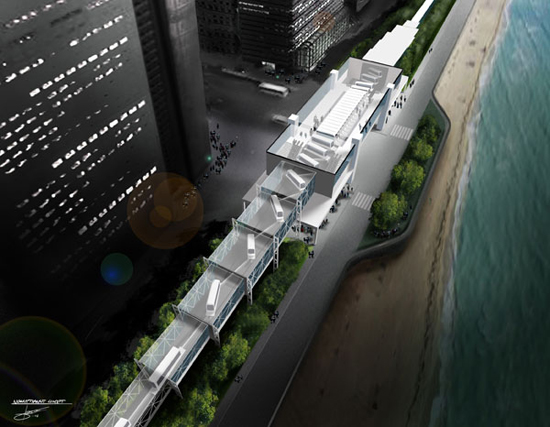 The NOWAITTRANSIT® track is constructed as a closed loop filled with cars individually coupled to each other through a distance beam. Each vehicle consists of an 8 m long car beam, an 8 m long distance beam, two bogies and a passenger compartment. Hence, the NOWAITTRANSIT® vehicle is 16 m long and 1,6 m wide. Each bogie consists of two conventional railway wheels and three guide wheels, which precludes derailment. The passenger compartment is located on top of the car beam via suspension system.
The NOWAITTRANSIT® track is constructed as a closed loop filled with cars individually coupled to each other through a distance beam. Each vehicle consists of an 8 m long car beam, an 8 m long distance beam, two bogies and a passenger compartment. Hence, the NOWAITTRANSIT® vehicle is 16 m long and 1,6 m wide. Each bogie consists of two conventional railway wheels and three guide wheels, which precludes derailment. The passenger compartment is located on top of the car beam via suspension system.
The NOWAITTRANSIT® Principle
Due to the factor 10 relation between vehicle length and vehicle width the speed is reduced by the same factor 10 as the vehicle rotates 90 degrees while entering a station. As the vehicle leaves the station it is rotated back to its initial position and the speed is regained. Nominally the speed is 10 m/s on the track and 1 m/s at the platform area. The energy is preserved by an uphill slope at the station entrance and by a corresponding downhill slope at the station exit, i.e. kinetic energy is transformed into potential energy and back to kinetic energy. The NOWAITTRANSIT® principle means that no energy is lost due to mechanical braking and the result is that the total energy consumption is less than 20 % compared to a conventional subway system.
Propulsion
The propulsion power to compensate for wheel-rail friction, elevation energy losses and air resistance is arranged by static linear motors fixed to the main track structure. The motors are located along the track at needed spacing requirements and the reaction beam is mounted on the car- and distance beams.
Control System
The vehicles are driverless and the operation is maneuvered from an external control room. No signal system is required since the vehicles are connected to each other, hence collisions are impossible. Sensors are monitoring the moving components so that malfunctions are avoided before they occur.
Maintenance
The only moving components on the vehicles subjected to mechanical wear are the wheels, bearings and the passenger compartment doors. The bogies can be replaced during operation and takes about 20 s. Also the door mechanisms can be replaced/ maintained during operation meaning that the system never has to stop, no maintenance facilities are required and the maintenance cost is kept to a minimum.
FURTHER READING: